Eueides isabella
Margarita Beltrán and Andrew V. Z. BrowerCharacteristics
Early stages: Eggs are cream coloured and approximately 1 x 0.9 mm (h x w). Females usually place 1 to 3 eggs under older and younger leaves of the host plant. Mature larvae have a black body with orange and yellow stripes and white bands, with black and white scoli and head, orange anal cap; length is around 1.7 cm. Caterpillars are gregarious in small numbers (Brown, 1981). Pupae are greenish white with black markings on the wingpads and short spines on dorsum that are tipped black (DeVries, 1997).
Geographical distribution
Eueides isabella is widely distributed from Central America to Brazil and also on the Greater Antilles. The map below shows an approximate representation of the geographic distribution of this species.
Geographical races
This widespread, geographically variable species has a number of named geographical races as follows (Lamas, 2004):
- Eueides isabella isabella (Stoll, 1781) - Guianas
- Eueides isabella arquata Stichel, 1903 - Colombia
- Eueides isabella cleobaea Geyer, 1832 - Cuba
- Eueides isabella dianasa (Hübner, [1806]) - Bahia, Brazil
- Eueides isabella dissoluta Stichel, 1903 - Peru
- Eueides isabella dynastes C. &. R. Felder, 1861 - Venezuela, Colombia
- Eueides isabella ecuadorensis Strand, 1912 - Ecuador
- Eueides isabella eva (Fabricius, 1793) - Central America
- Eueides isabella hippolinus Butler, 1873 - Peru
- Eueides isabella huebneri Ménétriés, 1857- Colombia
- Eueides isabella melphis (Godart, 1819) - Hispaniola, Puerto Rico
- Eueides isabella nigricornis R. G. Maza, 1982 - southern Mexico
Habits
E. isabella occurs from sea level to 1,500 m in secondary forests. Females mate multiply, often on hilltops. Adults roost solitarily at night under leaves (Brown, 1981).
Hostplant: E. isabella larvae feed primarily on plants from the subgenera Distephana and Granadilla (Passifloraceae)(Brown, 1981). In Costa Rica larvae feed on Passiflora platyloba, and P. ambigua (Passifloraceae) (DeVries, 1997).
References
Brown K. S. 1979. Ecologia Geográfica e Evolução nas Florestas Neotropicais. 2 vols. (Tese apresentada à Universidade Estadual de Campinas como parte das exigências de um Concurso de Livre Docência, area de Ecologia). Universidade Estadual de Campinas, Campinas, Brazil.
Brown K. S. 1981 The Biology of Heliconius and related genera. Annual Review of Entomology 26, 427-456.
DeVries P. J. 1997 The Butterflies of Costa Rica and Their Natural History, Volume I: Papilionidae, Pieridae, Nymphalidae Princeton University Press, Baskerville, USA.
Lamas, G. (ed.) 2004 Atlas of Neotropical Lepidoptera. Checklist: Part 4A Hesperioidea - Papiionoidea. Gainesville: Scientific Publishers/Association of Tropical Lepidoptera.
Stoll C. 1781 In: Cramer, P., De uitlandische Kapellen voorkomende in de drie Waereld-Deelen Asia, Africa en America. Papillons exotiques des trois parties du monde l'Asie, l'Afrique et l'Amérique. Amsteldam, J. S. Baalde; Utrecht, Barthelemy Wild. (29/31): 91-164, pls. 337-372 (1781).
Title Illustrations

| Scientific Name | Eueides isabella hippolinus |
|---|---|
| Specimen Condition | Dead Specimen |
| View | dorsal |
| Collection | Gerardo Lamas |
| Image Use |
 This media file is licensed under the Creative Commons Attribution-NonCommercial-ShareAlike License - Version 3.0. This media file is licensed under the Creative Commons Attribution-NonCommercial-ShareAlike License - Version 3.0.
|
| Copyright |
©

|
| Scientific Name | Eueides isabella hippolinus |
|---|---|
| Specimen Condition | Dead Specimen |
| View | ventral |
| Collection | Gerardo Lamas |
| Image Use |
 This media file is licensed under the Creative Commons Attribution-NonCommercial-ShareAlike License - Version 3.0. This media file is licensed under the Creative Commons Attribution-NonCommercial-ShareAlike License - Version 3.0.
|
| Copyright |
©

|
| Scientific Name | Eueides isabella dissoluta |
|---|---|
| Specimen Condition | Dead Specimen |
| View | dorsal |
| Collection | Gerardo Lamas |
| Image Use |
 This media file is licensed under the Creative Commons Attribution-NonCommercial-ShareAlike License - Version 3.0. This media file is licensed under the Creative Commons Attribution-NonCommercial-ShareAlike License - Version 3.0.
|
| Copyright |
©

|
| Scientific Name | Eueides isabella dissoluta |
|---|---|
| Specimen Condition | Dead Specimen |
| View | ventral |
| Collection | Gerardo Lamas |
| Image Use |
 This media file is licensed under the Creative Commons Attribution-NonCommercial-ShareAlike License - Version 3.0. This media file is licensed under the Creative Commons Attribution-NonCommercial-ShareAlike License - Version 3.0.
|
| Copyright |
©

|
About This Page

University of Cambridge, Cambridge, UK

Middle Tennessee State University, Murfreesboro, Tennessee, USA
Correspondence regarding this page should be directed to Margarita Beltrán at and Andrew V. Z. Brower at
Page copyright © 2009 and
 Page: Tree of Life
Eueides isabella .
Authored by
Margarita Beltrán and Andrew V. Z. Brower.
The TEXT of this page is licensed under the
Creative Commons Attribution-NonCommercial-ShareAlike License - Version 3.0. Note that images and other media
featured on this page are each governed by their own license, and they may or may not be available
for reuse. Click on an image or a media link to access the media data window, which provides the
relevant licensing information. For the general terms and conditions of ToL material reuse and
redistribution, please see the Tree of Life Copyright
Policies.
Page: Tree of Life
Eueides isabella .
Authored by
Margarita Beltrán and Andrew V. Z. Brower.
The TEXT of this page is licensed under the
Creative Commons Attribution-NonCommercial-ShareAlike License - Version 3.0. Note that images and other media
featured on this page are each governed by their own license, and they may or may not be available
for reuse. Click on an image or a media link to access the media data window, which provides the
relevant licensing information. For the general terms and conditions of ToL material reuse and
redistribution, please see the Tree of Life Copyright
Policies.
- First online 18 February 2007
- Content changed 25 February 2009
Citing this page:
Beltrán, Margarita and Andrew V. Z. Brower. 2009. Eueides isabella . Version 25 February 2009 (under construction). http://tolweb.org/Eueides_isabella/72965/2009.02.25 in The Tree of Life Web Project, http://tolweb.org/




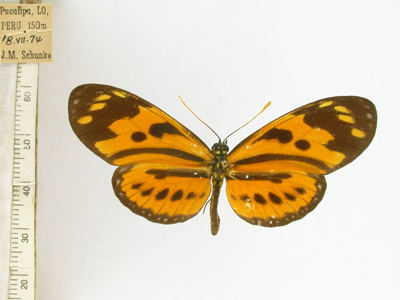
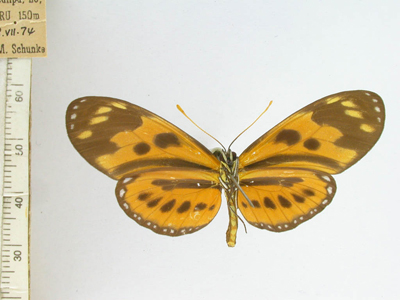
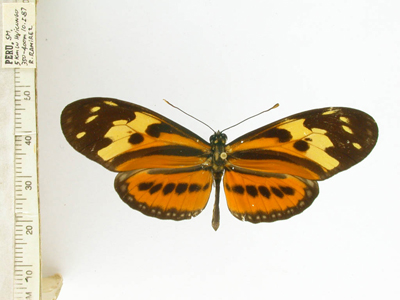
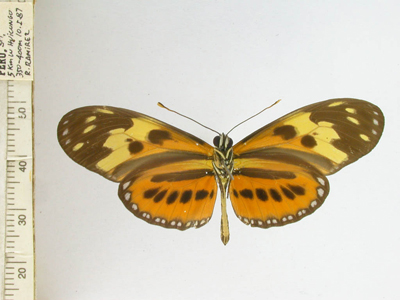
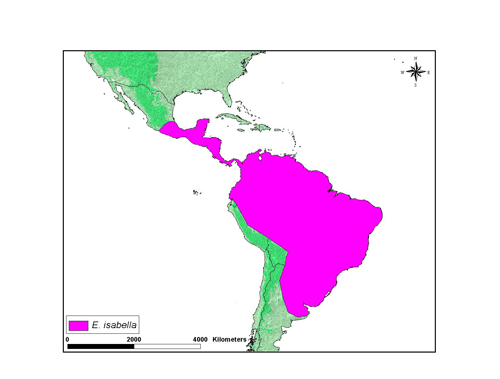


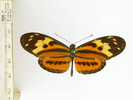



 Go to quick links
Go to quick search
Go to navigation for this section of the ToL site
Go to detailed links for the ToL site
Go to quick links
Go to quick search
Go to navigation for this section of the ToL site
Go to detailed links for the ToL site